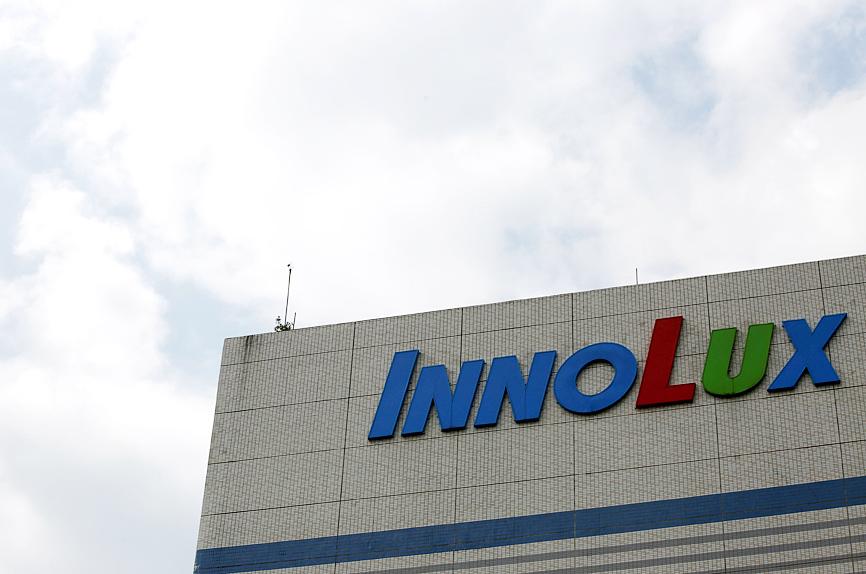Flat-panel maker Innolux Corp (群創) yesterday said that quarterly losses improved last quarter on the back of increased demand for panels for monitors, laptops and medical devices, as economies reopened in the US and Europe, and the COVID-19 pandemic drove remote learning and telecommuting trends.
Innolux’s net loss narrowed to NT$4.78 billion (US$161.82 million) during the April-to-June quarter, compared with a net loss of NT$5.2 billion in the first quarter, the company said in a statement.
That was the seventh consecutive quarterly loss reported by the Miaoli-based company. Innolux posted a net loss of NT$2.97 billion a year earlier.

Photo: Tyrone Siu, Reuters
However, gross margin last quarter returned to positive territory at 2.8 percent, from minus-1.8 percent a quarter earlier, but was still lower than 3.7 percent a year earlier.
“The demand for panels last quarter improved as European and US markets gradually recovered from lockdowns, and the stay-at-home economy helped spur demand,” Innolux said in the statement.
Those factors helped boost revenue by 32.7 percent sequentially to NT$66.88 billion last quarter, the company said.
Innolux said that economic stimulus measures launched by countries around the world would spur demand for TV panels in the third quarter.
TV makers have also been building up inventory ahead of the year-end shopping season, which helps propel panel demand, it said.
Robust demand for laptop and monitor panels would extend into this quarter due to work-from-home and remote learning trends, the company said.
Overall shipments of TV and PC panels this quarter would rise by a high single-digit percentage from last quarter, Innolux said.
This quarter, average selling prices for those panels would climb by a mid-single-digit percentage quarter-on-quarter, while shipments of small and medium panels would grow by a single-digit percentage compared with last quarter, thanks to demand for panels used in vehicles and 5G mobile phones recovering due to new product launches, it said.
Consulting firm Omidia Group said that Innolux and its local peer AU Optronics Corp (友達光電) would swing back into the black this quarter, benefiting from a V-shaped recovery, as panel prices are expected to surge 40 percent quarter-on-quarter.
Separately yesterday, Innloux in a filing with the Taiwan Stock Exchange said that it has transferred a batch of manufacturing equipment worth NT$446.85 million to its auto display manufacturing subsidiary, CarUX Technology Inc (群豐駿科技), to restart efforts to spin it off.

SEMICONDUCTORS: The firm has already completed one fab, which is to begin mass producing 2-nanomater chips next year, while two others are under construction Taiwan Semiconductor Manufacturing Co (TSMC, 台積電), the world’s largest contract chipmaker, plans to begin construction of its fourth and fifth wafer fabs in Kaohsiung next year, targeting the development of high-end processes. The two facilities — P4 and P5 — are part of TSMC’s production expansion program, which aims to build five fabs in Kaohsiung. TSMC facility division vice president Arthur Chuang (莊子壽) on Thursday said that the five facilities are expected to create 8,000 jobs. To respond to the fast-changing global semiconductor industry and escalating international competition, TSMC said it has to keep growing by expanding its production footprints. The P4 and P5

DOWNFALL: The Singapore-based oil magnate Lim Oon Kuin was accused of hiding US$800 million in losses and leaving 20 banks with substantial liabilities Former tycoon Lim Oon Kuin (林恩強) has been declared bankrupt in Singapore, following the collapse of his oil trading empire. The name of the founder of Hin Leong Trading Pte Ltd (興隆貿易) and his children Lim Huey Ching (林慧清) and Lim Chee Meng (林志朋) were listed as having been issued a bankruptcy order on Dec. 19, the government gazette showed. The younger Lims were directors at the company. Leow Quek Shiong and Seah Roh Lin of BDO Advisory Pte Ltd are the trustees, according to the gazette. At its peak, Hin Leong traded a range of oil products, made lubricants and operated loading

Citigroup Inc and Bank of America Corp said they are leaving a global climate-banking group, becoming the latest Wall Street lenders to exit the coalition in the past month. In a statement, Citigroup said while it remains committed to achieving net zero emissions, it is exiting the Net-Zero Banking Alliance (NZBA). Bank of America said separately on Tuesday that it is also leaving NZBA, adding that it would continue to work with clients on reducing greenhouse gas emissions. The banks’ departure from NZBA follows Goldman Sachs Group Inc and Wells Fargo & Co. The largest US financial institutions are under increasing pressure

TRENDS: The bitcoin rally sparked by US president-elect Donald Trump’s victory has slowed down, partly due to outflows from exchange-traded funds for the token Gold is heading for one of its biggest annual gains this century, with a 27 percent advance that has been fueled by US monetary easing, sustained geopolitical risks and a wave of purchases by central banks. While bullion has ticked lower since US president-elect Donald Trump’s sweeping victory in last month’s election, its gains this year still outstrip most other commodities. Base metals have had a mixed year, while iron ore has tumbled, and lithium’s woes have deepened. The varied performances highlight the absence of a single, over-riding driver that has steered the complex’s fortunes, while also putting the spotlight